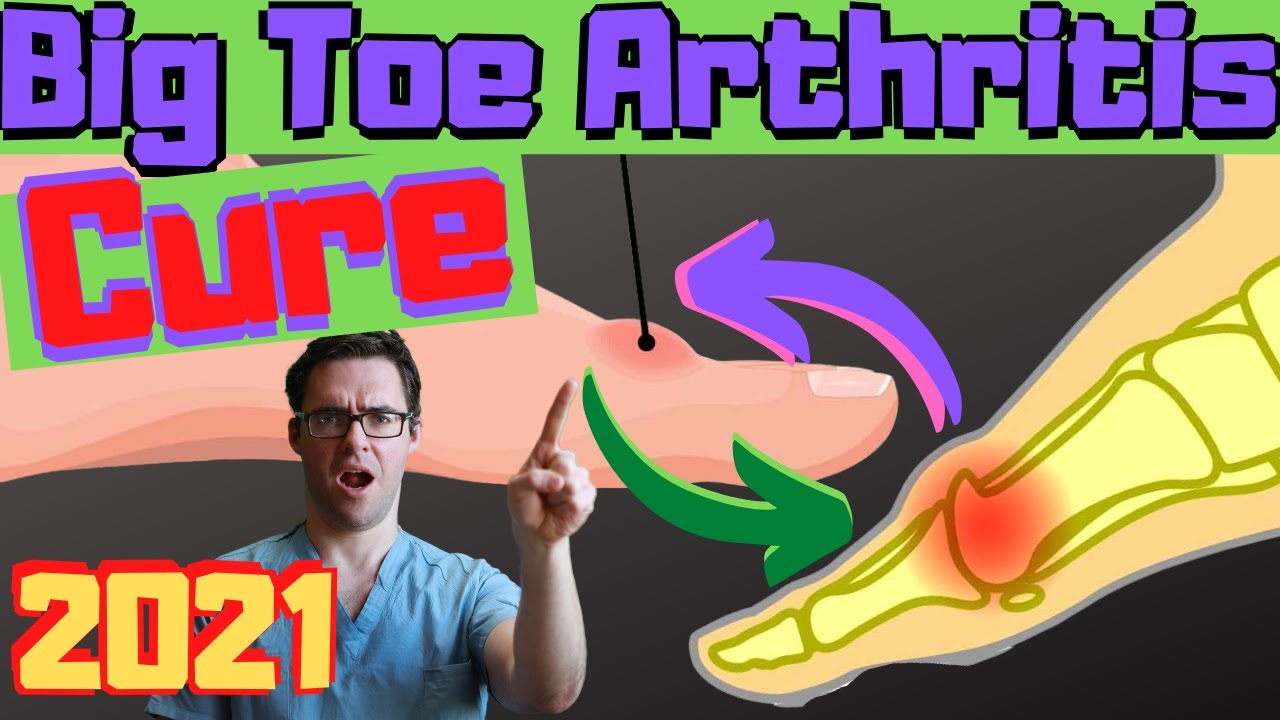Big Toe Joint, Hammer Toe & Bunionette Problems:
Hallux Rigidus Treatment [Exercises, Inserts, and Surgery?]
Hallux Rigidus Treatment is possible without surgery! Exercises don’t work great, but sometimes the right shoe and inserts make most pains DISAPPEAR!
Look:
- Big toe joint pain can be improved with a few simple treatment changes.
- We are foot doctors & we see this problem get better almost every day.
- The goal is to solve this problem without medication or surgery if possible.
So, let’s GO!
Table of Contents
Hallux rigidus pain relief video:
Best hallux rigidus surgery & treatment video summary:
This video goes over:
- hallux rigidus surgery
- Hallux rigidus treatment
- hallux rigidus shoes
- hallux rigidus exercises
- hallux rigidus pictures
- what is hallux rigidus?
- hallux rigidus surgery recovery time
- hallux rigidus symptoms
- hallux rigidus tests
Other causes of big toe joint pain:
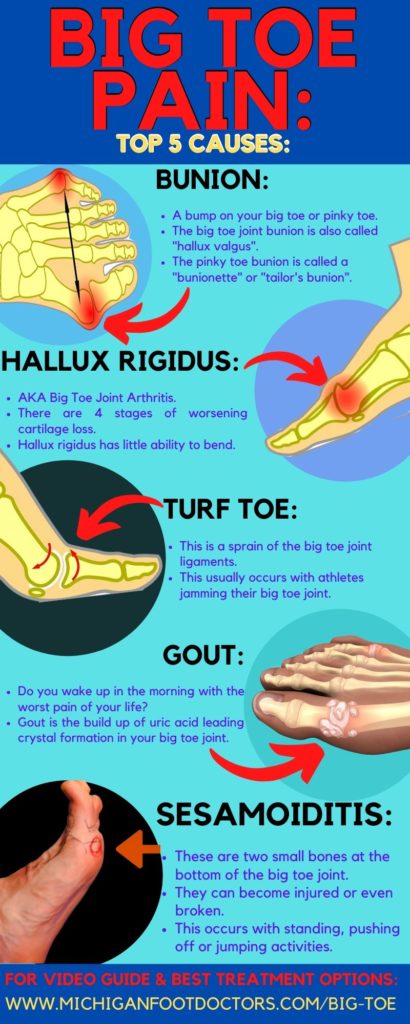
Big Toe Joint Arthritis & Hallux Rigidus Picture Gallery:
Look:
- Do you have a stiff big toe? This might mean that there is arthritis developing within your big toe joint.
- If you have a slight decrease in motion, this is called hallux limitus.
- If the big toe joint does not bend at all, this is called hallux rigidus.
- This does mean that there is destruction of your cartilage within the joint.
- As the joint keeps getting more and more damaged, it starts to develop a very large spur on the big toe joint.
- It is possible to also have a bunion in the big toe joint arthritis.
- It is possible to have sesamoiditis and big toe joint arthritis.
- It is possible to have a turf toe and big toe joint arthritis, although little bit less likely.
So, click on the gallery to see a description & full size photos!
Click on pictures for full size & descriptions:
Hallux Rigidus Symptoms:
- Pain at the base of the big toe during walking.
- A giant callus develops on the inside of the big toe joint.
- Stiffness in the MTP joint.
- Swelling and inflammation may be present.
- As the condition progresses, the patient may experience:
- A considerable loss of motion in the MTP joint.
- Pain even when resting.
- Pain on touching the top of the joint.
- Additional growths of bone may be felt here.
- A limp.
- Pains in the lower back, hips, or knees due to changes to walking patterns.
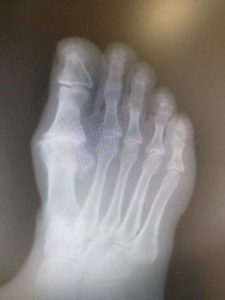
What Is Hallux Rigidus?
Hallux is the Latin word for the big toe, and rigidus literally means rigid or stiff.
- The big toe is important in walking and running as it dorsiflexes (bends back) during the push-off phase of the gait cycle.
In hallux rigidus, the movement in the joint at the base of the big toe (the metatarsophalangeal or MTP joint) gradually decreases.
Initially, hallux limitus is often used, and the term rigidus is used in the later stages as the movement becomes considerably reduced.
It is a form of degenerative arthritis, although it is often initially confused with a bunion.
The condition can cause further problems, especially with walking, requiring at least 60 degrees of dorsiflexion at the MTP joint for a ‘normal’ walking pattern.
If this is not available, compensations are made elsewhere, for example, the ankle, knee, and pelvis.
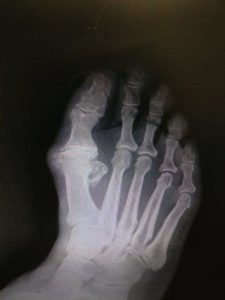
Hallux Rigidus Causes:
- Hallux rigidus can be caused by either a traumatic injury or overuse.
- Overpronation – increases the stress on the joint.
- Repetitive weight-bearing in a dorsiflexed position.
- Traumatic injury such as stubbing the big toe which can cause chondral (cartilage) damage.
- Hypermobile 1st metatarsal.
- Rheumatoid arthritis.
- Gout.
- A broken big toe joint.
- A loss of cartilage in the big toe joint.
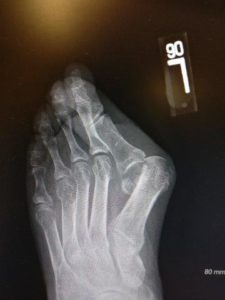
Hallux rigidus test:
The best way to test for hallux rigidus is to see whether or not the big toe can bend up.
In a healthy adult, the big toe joint should bend 90° upward, so the first metatarsal and the proximal phalanx joint should be able to bend 90° is upward.
In the office, a podiatrist would grab your proximal phalanx and tendon upwards. There are official grades of hallux rigidus.
A grade 4 shows no motion, a grade 1 shows reduced motion, a grade 2 shows decreased motion this arthritis, and a grade 3 shows about 10° or less motion.
Hallux limitus vs rigidus:
The difference between hallux limitus first hallux rigidus is that limitus means that there is limited joint motion. Hallux rigidus means that the joint is rigid and has no motion.
There are various grades of big toe joint stiffness.
Hallux limitus means that there is reduced motion. I officially it is about 60° or less of motion.
Hallux rigidus means that there is osteoarthritis in the first metatarsal phalangeal joint and that there is little or no motion in the big toe joint.
The difference between the hallux limitus first hallux rigidus is reduced motion vs. no motion.
Causes of Big Toe Joint Pain:
- A bunion is the beginning of the dislocation of the big toe joint.
- The official term is subluxation, this is when the first metatarsal phalangeal joint starts to come out of the joint.
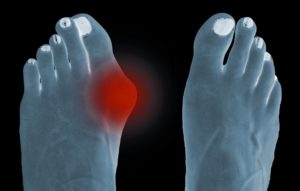
- This usually means the big toe joint is starting to point towards the second toe, this forces the second toe to rise over the big toe if it gets bad enough.
- This can contribute to forming a second toe hammer toe, as well as making the second, third, fourth, and fifth toes spread towards the outside of the foot.
- You can also develop a bunion to your fifth toe, this is called a tailor’s bunion, or a tailor’s bunionette.
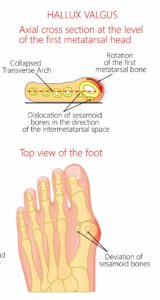
- A turf toe injury is the hyperextension of the first metatarsal phalangeal joint, also known as a big toe joint sprain.
- There are many tendons and ligaments and bones on the bottom of your big toe joint.
- If you strain the tendons and ligaments, these can take many weeks or many months to heal.
- If you ever watch professional football, or soccer, this is a very common sports injury when the big toe plants into the ground and all your body weight transfers over.
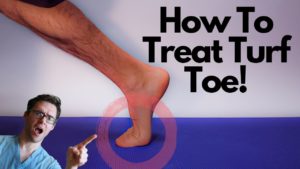
- There are two bones underneath your big toe joint called your sesamoids bones. These are the tibial sesamoid and the fibular sesamoid.
- If the big toe joint becomes disrupted, such as in a bunion these can become dislocated sesamoids.
- In sports such as basketball where there is a lot of pressure put on the big toe joint, this can lead to inflammation of the sesamoid bones. This is called the sesamoiditis.
- If your sesamoiditis gets really bad, it is also possible to get a broken sesamoid, or sesamoid fracture.
- It can be a good idea to see a podiatrist if you do have a broken or fractured sesamoid bone.
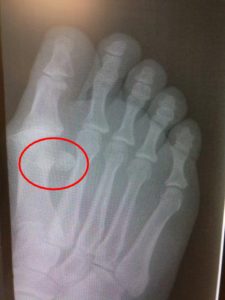
Big Toe Joint Arthritis (AKA Hallux Rigidus):
- Arthritis means that the cartilage is missing from your joint, this then prevents normal joint motion. Eventually as the damage keeps getting worse, the bone starts to crack, cause severe pain and eventually develop bone spurs and uneven bone at the site.
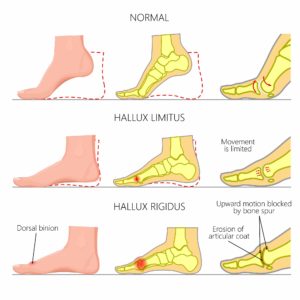
- In your big toe joint when you start to lose some motion, this is called hallux limitus. Eventually this starts to lose complete motion and this is now called hallux rigidus. This means that your big toe joint is rigid and unable to move.
- There are four stages to hallux rigidus,progressing from no arthritis to complete fused arthritis.
- Hallux rigidus and big toe joint arthritis essentially mean the same thing.
- This is a very common problem that we see especially in people who are on their feet all day, or have broken their toe in the past.
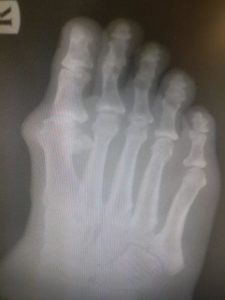
- Flat feet can be caused by many different things, and flat feet result in many different problems.
- The more your foot flattens, the more abnormal pressure is put onto your big toe joint. This can lead to abnormal pressure causing a dislocation also known as a bunion, or jamming of the cartilage which can lead to big toe joint arthritis or hallux rigidus.
- Flat fee are very complicated topic, as you can have a bunion in a high arched foot as well, but generally it is the act of over pronation that causes your big toe joint to receive pressure and become agitated.
- Controlling flat fee with more support has more pros than cons for sure.
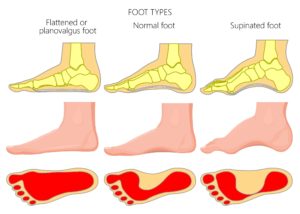
Hallux rigidus grades & stages:
Grade 1 hallux rigidus (Aka hallux limitus):
Grade 1 hallux rigidus involves some loss of range of motion of the big toe joint or first MTP joint and is often treated conservatively with custom-molded foot orthotics.
We also like a good pair of tennis shoes for hallux rigidus & potentially carbon fiber insoles. We also recommend using exercise and stretching as a treatment.
Grade 2 hallux limitus (aka hallux limitus):
Grade 2 hallux rigidus involves a greater range of motion and cartilage loss and may be treated via a hallux rigidus cheilectomy surgery. The metatarsal head is reshaped, and bone spurs are reduced.
We lean toward performing minimally invasive spur resection surgery in these cases.
This is still a good stage for using orthotics, shoes, and exercises.
Grade 3 hallux rigidus:
Grade 3 hallux rigidus often involves significant cartilage loss.
This means that the joint space is not completely gone but that there is already extensive osteoarthritis and joint range of motion decrease occurring.
There is little hope of getting a normal joint back at this stage, but it is possible to offload with orthotics, good shoes, and exercising to reduce symptoms significantly.
Surgery can be considered, such as joint replacement surgery or a big toe joint fusion as well.
Grade 4 hallux rigidus:
Grade 4 hallux rigidus, also known as end-stage bone on bone hallux rigidus with osteoarthritis.
This final grade involves severe loss of range of motion of the big toe joint and cartilage loss.
Grade 4 hallux rigidus may be treated via big toe joint fusion or implant arthroplasty.
When there is bone on bone osteoarthritis, the joint has minimal movement, and there will likely never be any regaining of joint motion.
Fusion of the joint is often viewed as more definitive but may lead to significant alteration of gait, causing postural symptomatology.
We still believe there can be excellent relief of symptoms with proper shoes and orthotics in even the final grade. If the expectations are reasonable, we do not believe that surgery is the only choice. Surgery is the only choice if your goal is zero motion in the joint, but this does not guarantee zero pain (although the results are generally in the 90-95% happy and would do it over again.
Big Toe Joint Home Treatment Infographic:
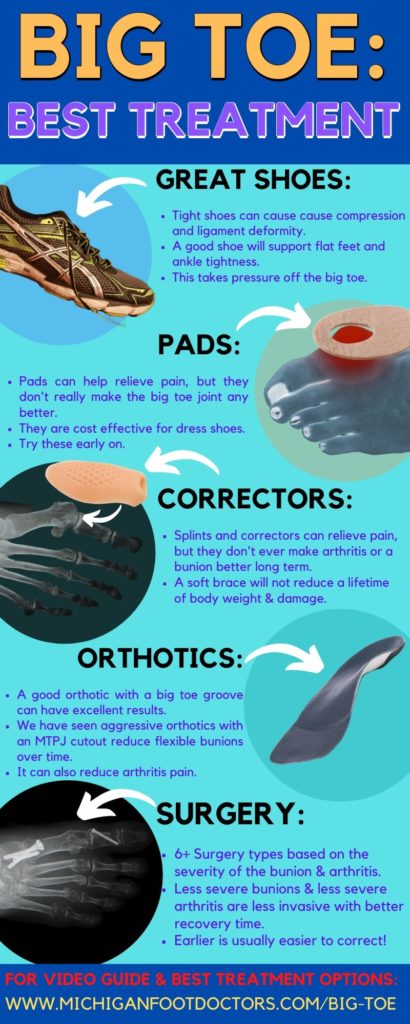
Hallux Rigidus Treatment:
- X-rays may display degeneration and excess bone growth at the MTP joint.
- Treatment is usually conservative, starting with a period of relative rest.
- Anti-inflammatory medications may be prescribed, or corticosteroid injection may be administered.
- Any contributing biomechanical factors such as overpronation should be corrected.
- Physical therapy may be employed to try to increase the range of motion at the joint using mobilizations.
- In extreme cases, surgery may be required to remove the bony growth on top of the joint, or even a total arthroplasty (joint replacement) may be used.
Cortisone shot for hallux rigidus?
A cortisone shot can sometimes be effective for calming down a flare-up of pain with hallux rigidus.
We find that this is only effective if he can also prevent new damage from occurring.
For example, this means that we would get good shoes, good orthotics, and a cortisone shot to calm down to hallux rigidus inflammation.
It is generally not a good idea to inject the joint and not correct the biomechanics that is causing the joint pain in the first place. This will usually be a losing battle, in our opinion.
Best Shoes for Hallux Rigidus:
- Properly measure yourself for your shoe using a Brannock Device at an athletic shoe store.
- Or watch out shoe fitting video.
- Getting some extra depth shoes and skip lacing should be enough to avoid putting pressure on the bump.
- Getting a great supportive pair of shoes will ensure that pressure is removed from your midfoot and top of the foot (big toe joint).
- This is especially important if you have plantar fasciitis or any other type of heel injury.
- Consider shoes combined with a good supportive orthotic for the best pain relief!
- The following link will show you what our favorites are.
Best hallux rigidus shoes:
These are the best running shoes for hallux rigidus:
Click for the best women’s hallux rigidus shoes.
Click for the best men’s hallux rigidus shoes.
Best sandals for hallux rigidus:
Sandal with built-in arch support can effectively take pressure off of hallux rigidus and hallux limitus.
Click for our favorite women’s sandals for hallux rigidus.
Click for our favorite men’s sandals for hallux rigidus.
Best slippers for hallux rigidus:
With so many people working from home and stuck at home, slippers are a great option for hallux rigidus.
These are the best slippers for hallux rigidus that we know of:
Click here for our favorite men’s slippers for hallux rigidus.
Click here for our favorite women’s slippers for hallux rigidus.
Best flip flops for hallux rigidus:
These are our best flip flops for hallux rigidus and sandals for hallux rigidus:
Click for our favorite women’s flip-flops for hallux rigidus.
Click for our favorite men’s flip-flops for hallux rigidus.
Hallux rigidus orthotics:
- A wide variety of prefabricated orthotics can be very effective as hallux rigidus orthotics.
- We did make a list of our favorite orthotics that can improve the lower extremity.
- This does include a modified arch as well as a carbon-fiber insole.
Carbon fiber insoles for hallux rigidus:
- These are our favorite carbon fiber insoles for hallux rigidus.
- These can be combined underneath a more soft orthotic for hallux rigidus on top of the firm orthotic.
- The carbon fiber insole will stop the big toe joint from bending, but it will not stop rubbing at the top of the shoe.
- Click this link for the Best Carbon Insole(For Broken or Stiff Toes).
Hallux rigidus insoles:
These are our favorite hallux rigidus insoles:
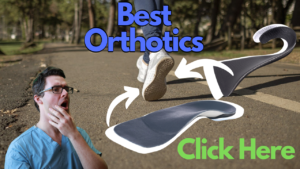
Best hallux rigidus brace:
In our opinion, the best brace for hallux rigidus is a carbon fiber insole to prevent the big toe joint from bending.
There are 2 types of hallux rigidus pain.
- There is rubbing against the top of the shoe.
- There is pain from bending the first metatarsal phalangeal joint.
A carbon fiber insole is the best type of treatment for bending through the first metatarsal phalangeal joint.
The best solution for the bump rubbing against the top of the shoe is a gel pad.
These can be the meager cost for a few dollars. This is a link to the hallux rigidus gel.
A good idea is also to buy a shoe with a soft top.
If you have hallux rigidus, it may not be the best idea to wear leather shoes, typically on top of the big toe joint.
Best hallux rigidus toe spacer:
These are our favorite hallux rigidus toe spacers:
Best hallux rigidus splint:
These are some of our favorite hallux rigidus splints:
Hallux Rigidus Exercises:
- Hallux rigidus exercises are out there, but they will not do anything for you, to be honest.
- In the video above, we go over the best hallux rigidus exercises and the best hallux limitus exercises.
- The entire problem with hallux rigidus is that it is a bone deformity, not a muscle or ligament problem.
- Hallux rigidus, by definition, is almost fused bone.
- Short of breaking apart this bone and giving it some room to move, exercises will not do much for you.
- With that said, hallux rigidus can definitely feel better without just jumping straight to surgery, but this means good hallux rigidus orthotics and good hallux rigidus running shoes!
Hallux Rigidus Surgery:
If you are in Michigan, consider coming to see us for a no-obligation consultation for minimally invasive hallux rigidus surgery.
Learn more about minimally invasive hallux rigidus foot surgery:
- Hallux rigidus surgery is something known as a cheilectomy.
- Hallux rigidus surgery is one of the beneficial and quickest recoveries big toe surgeries available.
- The surgery is as simple as simply going into the top of the joint and shaving out the spur.
- With the spur shaved out, the joint can now bend better.
The red portion in this picture is removed in hallux rigidus surgery. This is a very effective surgery with a quicker healing time. The downside is that it takes longer to heal this.
Hallux rigidus cheilectomy:
Hallux rigidus cheilectomy is another name for shaving a bone spur on top of the hallux rigidus first metatarsal phalangeal joint.
At our office, we performed a minimally invasive cheilectomy procedure that can be performed in the office. We find that this is a very effective procedure in some cases.
Not every patient can qualify for a procedure such as this. For example, if severe osteoarthritis within the joint itself, a first metatarsal phalangeal joint fusion procedure may be the better option.
In most cases, if the patient is eligible and does qualify, we find success with hallux rigidus cheilectomy in the office as a strong procedure choice. It leads to minimal incision formation, faster healing, and faster recovery.
Studies do show the first metatarsal joint fusion can be the more effective procedure in severe cases of osteoarthritis. Still, it is good to know that there will be no regeneration of joint motion.
Hallux rigidus joint replacement surgery:
A hallux rigidus surgery option is hallux rigidus joint replacement surgery. This surgical option can present in numerous ways. There is a new hallux rigidus surgery procedure called a Cartiva implant.
This small synthetic implant creates the space between the joint and prevents the bone from rubbing against itself.
On the other hand, there are what is termed joint destructive procedures, which include drilling a hole in the base of the shaft and resurfacing the entire joint, similar to a knee replacement or hip replacement.
This may be an option in less active patients, but this can be an extensive surgery that does not have the best results in very active people.
This 2020 study reviews hallux rigidus surgery options and joint replacement surgery.
Joint replacement surgery can be very effective in the right patient population. We rarely perform these due to having a lot of success with minimally invasive joint remodeling and big toe joint fusion procedures, which are more definitive.
Hallux rigidus surgery recovery time:
- Hallux rigidus surgery recovery time is usually much quicker than most bunion and big toe surgeries.
- Sutures generally stay in for 2-3 weeks.
- You can go back to a good supportive running shoe in approximately 2 weeks.
- Once you are back in a normal pair of shoes, it can still ache for a few more weeks, and you will definitely know it like a month, or two go by.
- As 1-2 months start to pass, you will ideally feel much better than before you have the spur removed and corrected.
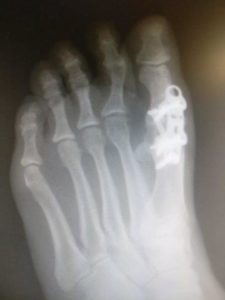
Here a big toe spur is visualized intra-operatively. This bump is shaved down intra-operatively with specialized equipment. This is then shaved and smoothed until the joint can move normally.
This is a different patient, but the joint looks much more smooth with the much better surface alignment of the big toe joint. When the big toe moves up and down, it now has an increased range of motion.
Hallux Rigidus Implant Surgery Options:
- There are two real options for implant surgery.
- There is a synthetic filler that is implanted into the joint.
- There are also big metal implants that can be implanted into the joint.
- These can work well for some people, but things can go really bad when they don’t work.
- The problem with these implants is that you have a foreign substance that is rubbing for years. This can destroy large chunks of bone in many patients and create a huge deficit in this area.
- If you want a quicker recovery – go with the cheilectomy.
- If you want a more permanent one and done surgery, go with the big toe joint fusion.
Big Toe Joint Fusion:
- A strong option for hallux rigidus surgery with a longer healing time is a big toe joint fusion.
- A big toe joint fusion is a longer healing procedure, but the benefit is that it is much more permanent and doubtful to reoccur in the future.
- This is the recommended surgery to take care of your big toe joint pain permanently.
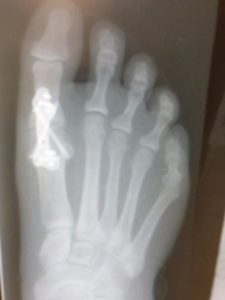
And don’t forget… GREAT shoes:
The best running shoes for hallux rigidus:
Frequently Asked Questions:
Can hallux rigidus cause knee pain?
Yes, hallux rigidus can cause knee pain.
Hallux rigidus is associated with a condition called overpronation.
Overpronation is the outward rotation of the foot, the dorsiflexion of the foot, and the eversion of the foot. It is 3 motions occurring of the foot to take pressure off the hallux rigid uses first metatarsal phalangeal joint.
This can lead to stretching of the medial knee ligaments and compression of the lateral knee.
If you want to learn more about overpronation and how it can relate to knee pain, we have a great overall guide and video detailing how knee pain could be offloaded by preventing overpronation.
This can also be aided by great shoes, great orthotics, and potentially a great lace-up ankle brace.
Rocker sole shoes for hallux rigidus:
Rocker sole shoes for hallux rigidus are very effective.
Our favorite brands of rocker sole shoes are now made with Hoka for both meds running shoes and women’s running shoes.
Here we provide her Lankes for our favorite commends running shoes and women’s running shoes.
These are the best rocker sole shoes for hallux rigidus:
Click for the best women’s hallux rigidus shoes.
Click for the best men’s hallux rigidus shoes.
Hallux rigidus & limitus contoured insoles:
Hallux rigidus and hallux limitus contoured insoles can be extremely beneficial.
2 types of insoles are effective for hallux rigidus.
We like people to consider carbon fiber insoles to prevent bending through the first metatarsal phalangeal joint. This prevents pain within the joint.
It is also a good idea to have a groove at the first MTPJ to prevent overpronation, which may be the cause of this hallux rigidus pain in the first place.
For this reason, it is beneficial to have a carbon fiber insole and a contoured insole over top of this carbon fiber insole.
We also recommend people have a soft material in the shoe over the bump if that is causing the pain.
It may not be easy to have a leather shoe rather than a soft material as this could cause rubbing on top of your shoe.
Hallux rigidus and sesamoiditis:
Hallux rigidus and sesamoiditis can be very closely related.
We have a great video going over how to treat sesamoiditis as well as sesamoiditis taping.
Click on this link for a guide to treat your sesamoiditis and hallux rigidus.
It is also possible for a stage IV hallux rigidus to call us frozen sesamoid syndrome.
This means that as advanced arthritis develops, this will freeze the 2 sesamoid bones into the hallux rigidus region.
Hallux rigidus exercises after surgery:
This 2020 study has shown that hallux rigidus exercises after surgery can be very beneficial.
We usually recommend people wait until the incision site heals, as the biggest risk is damaging the incision site.
As 2-3 weeks and the incision site begins to heal, it can make sense to start with gentle and passive range of motion exercises.
We recommend always checking with your doctor after surgery as your incision site needs to heal and be cleared by her doctor.
Hallux rigidus meaning:
The definition and hallux rigidus meaning is a stiff big toe joint.
The most common cause of a stiff big toe joint is osteoarthritis secondary due to unequal loading or partly be this injury-causing osteoarthritis.
Hallux rigidus with dorsal bunion:
Hallux rigidus with a dorsal bunion means a bone spur to the top of the first metatarsal phalangeal joint.
A dorsal bunion is a bump or a bone spur from excessive osteoarthritis that has developed on the top of the big toe joint.
The best way to assess this is to visit your podiatrist and get an x-ray to rule out any significant changes, such as a bone spur that may have developed.
At our office in Michigan, we do offer no-obligation consultation for minimally invasive surgery to smooth down these bone spurs in the office.
For more significant osteoarthritis in the big toe joint replacement or a big toe, joint fusion may be an indicated procedure.
Big toe joint pain hallux rigidus?
There are 2 types of big toe joint pain from hallux rigidus.
One type of pain is the big toe joint bending, and I would like to prevent this by using a carbon fiber insole.
The second type of pain is from the dorsal bunion or the bump on the top of the toe joint rubbing against the shoe.
For this reason, we like to pick shoes with a soft material on top of the shoe rather than a hard leather or constrictive shoe.
Hallux rigidus cortisone injection?
Hallux rigidus cortisone injection can be very effective in calming down hallux rigidus inflammation.
We do not rely on just the injection to calm down the inflammation, as we would also insist on using a good shoe, a good orthotic, and identifying why the hallux rigidus is happening in the first place to prevent that pain from developing continually in the future.
Difference between hallux valgus and hallux rigidus?
The difference between hallux valgus and hallux rigidus is the development of osteoarthritis.
Hallux valgus is the dislocation and deviation of the first metatarsal phalangeal joint.
Hallux rigidus, on the other hand, is the development of osteoarthritis preventing joint bending.
In some cases, hallux valgus can develop osteoarthritis, and there can be overlap in both.
It is possible to have both joint deviations and osteoarthritis of the joint, preventing motion in some cases.
This scenario would describe both hallux valgus and hallux rigidus developing in the same joint.
But officially, hallux valgus is the subluxation or dislocation of the first metatarsal phalangeal joint, and hallux rigidus is the development of osteoarthritis causing rigidity of the joint.
Hallux rigidus and plantar fasciitis?
Hallux rigidus and plantar fasciitis can be associated.
Both hallux rigidus and plantar fasciitis are associated with a condition called overpronation.
Overpronation is related to numerous foot conditions that are caused by an overload of inappropriate motion.
Overpronation means that your foot is flattening outward, turning more pressure onto the big toe joint, and stretching the plantar fascia.
We have a very in-depth guide on what overpronation is and how to take care of overpronation.
New procedure for hallux rigidus?
A new procedure for hallux rigidus to his call the Cartiva the implant. This is a form of hallux rigidus joint replacement surgery without implanting metal.
The active implant is a small piece of synthetic material put into the proximal phalanx’s head.
This prevents compression against the proximal phalanx.
This procedure was initially prevalent.
We personally do not have a lot of experience with it as we are still waiting for further resurgence studies to come out.
We agree with this 2020 study about the Cartiva Implant for hallux rigidus.
We have read both good things and potential concerns that still have us waiting for further information.
Hallux rigidus inflammation?
Hallux rigidus inflammation develops secondary to abnormal joint rubbing within the joint.
A second cause is the top of the first metatarsal phalangeal joint, where a dorsal bunion can rub against the top of the shoe.
Our preferred way of cooling down inflammation is to ice the hallux rigidus joint, offload it with good shoes and orthotics. Finally, we consider potentially injecting the first metatarsal phalangeal joint.
Hallux rigidus osteoarthritis?
Hallux rigidus becomes stiff due to osteoarthritis.
Osteoarthritis is one type of arthritis that leads to the loss of cartilage in the formation of bone spurs and joint space loss.
Eventually, the hallux limitus becomes what is known as bone-on-bone osteoarthritis and hallux rigidus.
How much does hallux rigidus surgery cost?
A common question can be “How much does hallux rigidus surgery cost?”, The answer is most major insurance plans generally cover this surgery.
A painful bone spur and bone on bone osteoarthritis and hallux rigidus can indicate surgery if there is already a loss of joint space.
We do perform an in-office hallux rigidus bone spur debridement surgery.
This is considered minimally invasive surgery, and as such, this does lower the overall cost burden compared to many other surgery options.
For example, it can be very costly to go to the hospital and perform a first metatarsal phalangeal joint fusion.
Still, minimally invasive hallux rigidus surgery can be significantly less in the range of $2-$3000 or less in some cases.
Consider seeing us for a no-obligation consultation for your hallux rigidus joint pain.
What is hallux rigidus surgery?
Hallux rigidus surgery can focus on trimming the bone spur.
One option is minimally invasive shaving of the spur.
Other options are joint replacement surgery and big toe joint fusion surgery to address arthritis in the middle of the joint.
These have been very effective procedures for us in the past, and studies show that the success rate for the patient can be in the 90-95% range.
What is the recovery time for hallux rigidus surgery?
The common question is, “What is the recovery time for hallux rigidus surgery?” The answer is it depends on the type of surgery.
A minimally invasive hallux rigidus surgery called a cheilectomy can avoid an incision and allow immediately protected weight-bearing.
This means a dressing will be in place until the incision site heals fully, and the foot will be sore for a few weeks or up to a month or 2.
But the benefit is the patient would be able to put weight on foot without significant problems almost immediately.
On the other end of the healing spectrum are joint replacement surgery and big toe joint fusion surgery.
It can take 2-3 weeks for the incision site to heal, and then it can take about 2-3 months for the soreness to go away.
In these procedures, we usually try to protect the foot for a few weeks until the incision site heals, and then we transition into protected weight-bearing until the pain goes away the rest of the way.
What to do for athletes with hallux rigidus?
We frequently see athletes with hallux rigidus.
This is common in people who have broken the big toe joint or absorb a lot of trauma to the foot.
Our favorite treatment options are a good pair of running shoes, a carbon-fiber insole, and get over-the-counter orthotic to take pressure off the big toe joint.
An option for the big toe joint is a big toe joint fusion. This can impair walking but reduce pain.
The most common athletes with hallux rigidus are those who broke their big toe joint and the cartilage cracked. This can make it difficult for it to ever heal again.
What are the best tennis shoes for hallux rigidus?
We had a nice long list of our favorite tennis shoes for hallux rigidus and walking shoes for hallux rigidus.
Click on this list for our favorite overall shoes.
What is the best footwear for hallux rigidus?
We like people to have many different options for hallux rigidus for both right foot hallux rigidus and left foot hallux rigidus.
If people are at home most of the time, we still recommend that they wear good running shoes and good orthotics for inside the shoe.
People can also wear good supportive orthotic slippers inside the house.
It is also possible to have good supportive sandals for the inside of the house.
What are the best sneakers for hallux rigidus?
This is our favorite list of the best sneakers for hallux rigidus.
Click here for our favorite list of sneakers for hallux rigidus.
Can hallux rigidus cause plantar fasciitis?
Yes, hallux rigidus can cause plantar fasciitis.
Hallux rigidus and plantar fasciitis are both associated with the condition called overpronation.
When the foot overpronates, he can inappropriately load the first metatarsal phalangeal joint. They can also stretch the plantar fascia to the bottom of the right foot and the left foot.
Helping control overpronation can lead to the reduction of hallux rigidus pain and plantar fascia pain.
We like to use shockwave therapy to break up any thick scar tissue that has developed over the years to the plantar fascia with shockwave therapy.
Click this link to learn more about overpronation treatment.
The difference between gout vs. hallux rigidus?
What is the difference between gout and hallux rigidus?
Gout is the buildup of uric acid within the joint. This normally comes as an attack when you wake up in the morning. It usually starts rapidly and ends over a few days on average. Everybody is a little bit different, but it usually follows a combination of dehydration, drinking alcohol, and eating seafood and meat.
Hallux rigidus, on the other hand, is osteoarthritis that gradually forms over years or decades. Hallux rigidus can flare up but generally never really goes away. Hallux rigidus could also follow after a broken big toe joint.
Is hallux rigidus a disability?
Depending on who the patient is, hallux rigidus can be a disability.
This can prevent athletes from playing sports, and it can prevent people who need to bend their big toe joints from being able to perform their tasks.
For example, people who need to be on the floor bending their big toe joints will have difficulty doing this. This could mean contractors, laborers, people who have to work on tiles or install flooring.
For this reason, hallux rigidus can be a disability. See your podiatrist or primary care doctor to see exactly how much correction or improvement can be achieved for hallux rigidus.
Running after hallux rigidus surgery?
Depending on the hallux rigidus surgery, it is possible to return to full running.
We find the best results with good orthotics, a groove for the first MTPJ, and a carbon fiber insole combined with good shoes.
Even a great toe joint fusion will allow someone to run postoperatively after the joint has healed completely.
Everyone differs, but running is sometimes more than just the big toe joint.
As an example, it can be more important to work on your flexibility for calf muscle, your hamstring, and your foot to gain even more improvement through your running ability rather than trying to regain the function of your first metatarsal phalangeal joint.
As another example, someone who weighs 100 pounds and is athletic will likely have a better time running even with hallux rigidus than someone who is flexible stiff, and sore throughout all the other joints and out of shape.
Talk with your podiatrist about your specific situation and see if your podiatrist’s hallux rigidus can be resolved.
Toe exercises for hallux rigidus?
When cleared and able to do so after surgery, we strongly recommend toe exercises to prevent future adhesions or scar tissue.
Hallux rigidus is osteoarthritis. Thus exercise will never truly resolve arthritis through the first metatarsal phalangeal joint.
On the other hand, working on calf muscle flexibility, plantar fascial flexibility, hamstring flexibility, significant improvements in athleticism, and functionality could improve.
Watch the treatment video at the start of this page to evaluate the best toe exercises for hallux rigidus. But full disclosure, arthritis will never become more flexible, only the joints that support the big toe joint.
What is the difference between hallux rigidus and hallux valgus?
What is the difference between hallux rigidus and hallux valgus?
The difference is that hallux rigidus is osteoarthritis with the loss of joint space.
Whereas hallux valgus is the dislocation displacement of the first metatarsal phalangeal joint.
Procedures podiatrists can perform in the office:
- Podiatrists can perform minimally invasive hallux rigidus surgery in the office.
- See our foot doctors for a no-obligation consultation in Michigan to see if minimally invasive surgery may be a good choice for you.
We can perform toenail, toe, foot, heel & ankle surgery in the office!
We can help with:
- Minimally invasive foot surgery.
- Minimally invasive bunion surgery.
- Minimally invasive hammertoe surgery.
- Corn and callus removal surgery.
- Plantar wart removal surgery.
- In-office permanent ingrown toenail removal surgery.
- Removal of unwanted spurs, bumps, or lumps on your feet.
- Shockwave therapy (AKA ESWT therapy or EPAT therapy)
- Cold laser therapy.
- MLS laser therapy (Multi-Wave Locked System laser therapy).
- Laser for peripheral neuropathy.
- 3D custom orthotic scan.
Big Toe Joint, Hammer Toe & Bunionette Problems:
